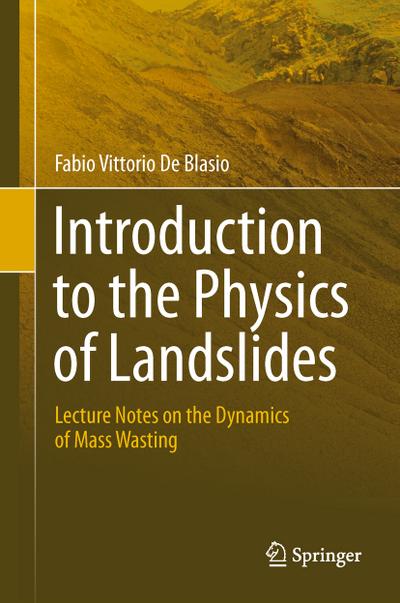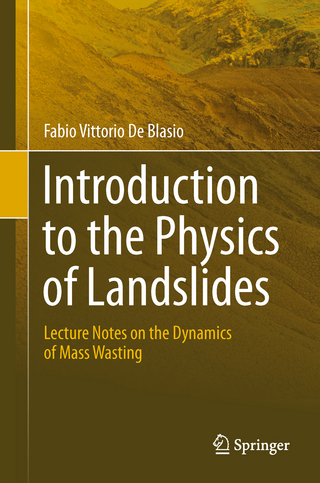
2023, ISBN: 9789401781480
[ED: Taschenbuch], [PU: Springer Netherlands], Neuware - Landslides represent one of the most destructive natural catastrophes. They can reach extremely long distances and velocities, and… Meer...
| booklooker.de |

Introduction to the Physics of Landslides : Lecture notes on the dynamics of mass wasting - pocketboek
2014, ISBN: 9401781486
[EAN: 9789401781480], Neubuch, [PU: Springer Netherlands], ENGINEERINGGEOLOGY; GEOHAZARDS; GRANULARMEDIA; ROCKAVALANCHES; GRAVITY, Druck auf Anfrage Neuware - Printed after ordering - Lan… Meer...
| AbeBooks.de AHA-BUCH GmbH, Einbeck, Germany [51283250] [Rating: 5 (von 5)] NEW BOOK. Verzendingskosten:Versandkostenfrei. (EUR 0.00) Details... |

2014, ISBN: 9789401781480
[ED: Softcover], [PU: Springer / Springer Netherlands], Landslides represent one of the most destructive natural catastrophes. They can reach extremely long distances and velocities, and … Meer...
| booklooker.de buecher.de GmbH & Co. KG Verzendingskosten:Versandkostenfrei, Versand nach Deutschland. (EUR 0.00) Details... |

Introduction to the Physics of Landslides / Lecture notes on the dynamics of mass wasting / Fabio Vittorio De Blasio / Taschenbuch / Paperback / xv / Englisch / 2014 / Springer Netherland - pocketboek
2014, ISBN: 9789401781480
[ED: Taschenbuch], [PU: Springer Netherland], Landslides represent one of the most destructive natural catastrophes. They can reach extremely long distances and velocities, and are capabl… Meer...
| booklooker.de |

2014, ISBN: 9789401781480
Lecture notes on the dynamics of mass wasting, Buch, Softcover, 2011 ed. [PU: Springer], Springer, 2014
| lehmanns.de Verzendingskosten:Versand in 10-14 Tagen. (EUR 0.00) Details... |


2023, ISBN: 9789401781480
[ED: Taschenbuch], [PU: Springer Netherlands], Neuware - Landslides represent one of the most destructive natural catastrophes. They can reach extremely long distances and velocities, and… Meer...

Fabio Vittorio De Blasio:
Introduction to the Physics of Landslides : Lecture notes on the dynamics of mass wasting - pocketboek2014, ISBN: 9401781486
[EAN: 9789401781480], Neubuch, [PU: Springer Netherlands], ENGINEERINGGEOLOGY; GEOHAZARDS; GRANULARMEDIA; ROCKAVALANCHES; GRAVITY, Druck auf Anfrage Neuware - Printed after ordering - Lan… Meer...

2014
ISBN: 9789401781480
[ED: Softcover], [PU: Springer / Springer Netherlands], Landslides represent one of the most destructive natural catastrophes. They can reach extremely long distances and velocities, and … Meer...

Introduction to the Physics of Landslides / Lecture notes on the dynamics of mass wasting / Fabio Vittorio De Blasio / Taschenbuch / Paperback / xv / Englisch / 2014 / Springer Netherland - pocketboek
2014, ISBN: 9789401781480
[ED: Taschenbuch], [PU: Springer Netherland], Landslides represent one of the most destructive natural catastrophes. They can reach extremely long distances and velocities, and are capabl… Meer...

2014, ISBN: 9789401781480
Lecture notes on the dynamics of mass wasting, Buch, Softcover, 2011 ed. [PU: Springer], Springer, 2014
Bibliografische gegevens van het best passende boek
| auteur: | |
| Titel: | |
| ISBN: |
Gedetalleerde informatie over het boek. - Introduction to the Physics of Landslides
EAN (ISBN-13): 9789401781480
ISBN (ISBN-10): 9401781486
pocket book
Verschijningsjaar: 2011
Uitgever: Springer
Boek bevindt zich in het datenbestand sinds 2015-07-02T13:00:35+02:00 (Amsterdam)
Detailpagina laatst gewijzigd op 2024-03-25T13:05:04+01:00 (Amsterdam)
ISBN/EAN: 9789401781480
ISBN - alternatieve schrijfwijzen:
94-017-8148-6, 978-94-017-8148-0
alternatieve schrijfwijzen en verwante zoekwoorden:
Auteur van het boek: blasio, blasi, bläsi
Titel van het boek: lecture notes physics, landslide
Gegevens van de uitgever
Auteur: Fabio Vittorio de Blasio
Titel: Introduction to the Physics of Landslides - Lecture notes on the dynamics of mass wasting
Uitgeverij: Springer; Springer Netherland
408 Bladzijden
Verschijningsjaar: 2014-11-23
Dordrecht; NL
Gedrukt / Gemaakt in
Taal: Engels
160,49 € (DE)
164,99 € (AT)
177,00 CHF (CH)
POD
XV, 408 p.
BC; Hardcover, Softcover / Geowissenschaften/Sonstiges; Geowissenschaften; Verstehen; Engineering Geology; Geohazards; Granular media; Landslides; Rock avalanches; gravity; Geotechnical Engineering and Applied Earth Sciences; Environmental Physics; Soft and Granular Matter; Physical Geography; Umwelt; Angewandte Physik; Physik der kondensierten Materie (Flüssigkeits- und Festkörperphysik); Physische Geographie und Topographie; BB; EA
Landslides represent one of the most destructive natural catastrophes. They can reach extremely long distance and velocity, and are capable of wiping out human communities and settlements. Yet landslides have a creative facet as they contribute to the modification of the landscape. They are the consequence of the gravity pull jointly with the tectonic disturbance of our living planet.Landslides are most often studied within a geotechnical and geomorphological perspective. Engineering calculations are traditionally applied to the stability of terrains. In this book, landslides are viewed as a physical phenomenon. A physical understanding of landslides is a basis for modeling and mitigation and for understanding their flow behavior and dynamics. We still know relatively little about many aspects of landslide physics. It is only recently that the field of landslide dynamics is approaching a more mature stage. This is testified by the release of modelling tools for the simulationof landslides and debris flows. In this book the emphasis is placed on the problems at the frontier of landslide research. Each chapter is self-consistent, with questions and arguments introduced from the beginning.The material should be useful to geologists, model developers, professionals and researchers in the fields of engineering, physics and mathematics, and advanced students of geosciences.One of the first books providing a thorough treatment of the physical basis of landslides The book contains large sections on the physics of granular media, experimental studies of landslides, numerical models and the relevant fluid mechanics The book presents detailed reports on 12 case studies The advanced and didactically-oriented text will be useful to researchers and professionals in addition to students Includes supplementary material: sn.pub/extras
Andere boeken die eventueel grote overeenkomsten met dit boek kunnen hebben:
Laatste soortgelijke boek:
9789400711211 Introduction to the Physics of Landslides: Lecture notes on the dynamics of mass wasting Fabio Vittorio de Blasio Author (Fabio Vittorio De Blasio)
< naar Archief...

